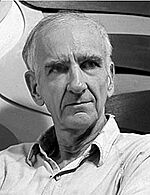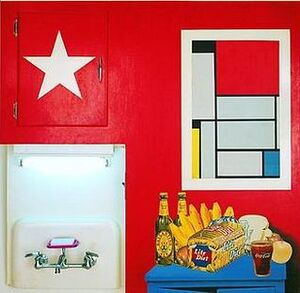Tom Wesselmann facts for kids
Quick facts for kids
Tom Wesselmann
|
|
|---|---|
 |
|
| Born | February 23, 1931 Cincinnati, Ohio, US
|
| Died | December 17, 2004 (aged 73) New York City, US
|
| Education | Art Academy of Cincinnati Cooper Union |
| Known for | Painting, Collage, Sculpture, Assemblage, Printmaking |
| Movement | Pop art |
Thomas K. Wesselmann (born February 23, 1931 – died December 17, 2004) was an American artist. He was known for his connection to the Pop Art movement. Tom Wesselmann created art using painting, collage, and sculpture.
Contents
Tom Wesselmann's Early Life
Tom Wesselmann was born in Cincinnati, Ohio. He went to college in Ohio from 1949 to 1951. First, he studied at Hiram College, then he moved to the University of Cincinnati to study psychology.
In 1952, he joined the US Army. During his time in the army, he started drawing cartoons. He became very interested in becoming a cartoonist. After leaving the army, he finished his psychology degree in 1954. Then, he began to study drawing at the Art Academy of Cincinnati. He even sold his first cartoon strips to magazines like 1000 Jokes and True.
In 1956, Wesselmann was accepted into Cooper Union in New York. While visiting the MoMA (Museum of Modern Art), he saw a painting by Robert Motherwell. This painting, called Elegy to the Spanish Republic, really inspired him. He felt a strong, exciting feeling inside.
Wesselmann also admired the work of another artist, Willem de Kooning. However, he soon decided to find his own unique style. He realized he needed to create art that was very different from what he admired in de Kooning.
The year 1958 was very important for Wesselmann. He went on a painting trip to rural New Jersey. There, he realized he wanted to be a painter, not a cartoonist.
Wesselmann's Art Career

After graduating, Wesselmann helped start the Judson Gallery. He showed some of his small collages there. He also started teaching art at a public school in Brooklyn. Later, he taught at the High School of Art and Design.
Early Works (1959–1964)
Wesselmann became well-known for his series called Great American Nude. He started this series in 1961. One day, he had a dream about the colors "red, white, and blue." This made him decide to paint the Great American Nude using only those colors. He also used colors found in patriotic things, like gold.
His art often included images from magazines and old posters. These images were glued onto his paintings, a technique called collage. Because of this, his works became very large. He even asked advertisers for old billboards to use in his art.
In 1962, Richard Bellamy offered Wesselmann a solo art show. Around the same time, Ivan Karp from the Leo Castelli Gallery introduced Wesselmann to other artists. These included Roy Lichtenstein and James Rosenquist. Wesselmann saw their art but didn't think it was similar to his own.
The idea of Pop Art was becoming popular. Pop Art uses images from popular culture, like advertisements and comic books. In November 1962, the Sidney Janis Gallery held a show called New Realists. This show included works by many American and European artists. It was a big moment for what would become known as Pop Art.
Wesselmann took part in this show. He showed two of his Still Life works from 1962. However, he never really liked being called a "Pop Art" artist. He felt his art used everyday objects for their beauty, not to criticize them. He said he disliked labels, especially "Pop," because it focused too much on the materials he used.
In 1962, Wesselmann also started a new series of still lifes. He began to experiment with assemblage, which means putting different objects together in a piece of art. In one work, Still Life #28, he included a television set that was turned on. He liked how the TV, with its moving images and sound, interacted with the painted parts. He enjoyed mixing different realities in his art.
In November 1963, Tom Wesselmann married Claire Selley. In 1964, he started working on landscapes. He also began creating his first "shaped canvas" nudes. These were paintings on canvases that were cut into shapes, not just simple rectangles.
New Directions (1965–1970)
During these years, Wesselmann continued his Great American Nude series. He also worked on landscapes. He started making nudes that were three-dimensional, using molded Plexiglas shaped like the female body.
His focus became more detailed. He started a series called Mouth in 1965, focusing only on lips. His Seascapes began the next year. He also introduced two new themes: Bedroom Painting and Smoker Study. The Smoker Study series, which showed a smoking mouth, became one of his most common themes in the 1970s.
From 1965, Wesselmann made many oil paintings for his seascape studies. He often used a projector to make them very large. These were part of his Drop-Out series. He also started using shaped canvases more often, making his works even bigger.
He worked a lot on his Bedroom Painting series. In these works, he focused on a few details of a person, surrounded by flowers and other objects.
Art in the 1970s
Wesselmann created Still Life #59, a large, complex painting made of five panels. It featured enlarged objects, including part of a telephone. It also showed a nail-polish bottle, roses, and a picture of actress Mary Tyler Moore. Wesselmann saw her as the perfect girlfriend. These works included more recognizable portraits.
In Bedroom painting #12, he even put in a self-portrait. In 1974, Still Life #60 appeared. This huge painting, almost 26 feet (8 meters) long, used the outline of sunglasses as a frame. Inside, it showed lipstick, nail polish, and jewelry. It was a giant look at modern femininity.
His Smokers series also changed. He added a hand with shiny fingernails, sparkling in the smoke. In 1973, he finished the Great American Nude series with The Great American Nude #100.
In 1978, Wesselmann started new Bedroom Paintings. In these, he changed the way he put things together. He often used a diagonal line to cut the picture, with a woman's face taking up a large part of the foreground.
Innovations in the 1980s
In 1980, Wesselmann published a book about himself called Tom Wesselmann. He wrote it under the name Slim Stealingworth. His second daughter, Kate, was born around this time. He also had two other children, Jenny and Lane.
In 1983, Wesselmann had an idea to make drawings out of steel. He wanted the lines he drew on paper to be cut out of metal and placed on a wall. This way, they would look like they were drawn right on the wall. At first, the technology to cut metal so precisely wasn't available. He had to help develop a system that could do this. It took another year for it to be ready.
He continued using "negative space" (the empty space around objects) in his new metal works. He started with black and white metal nudes. Then, he decided to make them in color too. In 1984, he also began making quick landscape sketches. These were then made into large aluminum sculptures.
Working with metal meant he had to try different techniques. He cut aluminum by hand. For steel, he researched and developed the first artistic use of laser-cut metal. Computerized imaging, which helps with such precise cutting, was not yet common.
Abstract Art in the 1990s
Wesselmann's metal works kept changing. In 1990, he made My Black Belt, which was a subject from the 1970s. It gained a new energy in the metal medium.
In 1993, Wesselmann said, "Since 1993 I’ve basically been an abstract painter." He explained that when he was working with the leftover pieces of his steel and aluminum cut-out figures, he saw many abstract possibilities. He realized he was going back to what he wanted to do in 1959. He started making abstract, three-dimensional shapes from cut metal. He felt happy and free to create art in his own way. In this new abstract style, Wesselmann often used a random approach. His metal cut-outs looked like brushstrokes.
His canvas nudes from this time were new versions of his 1960s images. They were a look back at his earlier work. In 1999, he made his last Smoker work, Smoker #1 (3-D), which was a relief sculpture in aluminum.
Final Years (2000–2004)
In his last ten years, Wesselmann's health was not good due to heart disease. However, he kept creating art steadily.
His abstract works from this period had stronger lines and used mostly primary colors. Wesselmann showed the influence of Piet Mondrian by naming some works after Mondrian's style, like New York City Beauty (2001). During these years, the influence of Matisse helped blend Wesselmann's realistic and abstract styles. In 1960, Wesselmann had seen Matisse's cut-out works. Forty years later, he honored Matisse in his Sunset Nudes series. In Sunset Nude with Matisse (2002), he included Matisse's painting La Blouse Roumaine. Wesselmann also made works inspired by Matisse's cut-outs, like Blue Nude (2000), which started a series of blue nude relief sculptures made from shaped aluminum.
After heart surgery, Tom Wesselmann passed away on December 17, 2004. His last major paintings, from the Sunset Nudes series (2003/2004), were shown after his death in New York in 2006.
Tom Wesselmann's Personal Life
In 1957, Wesselmann met Claire Selley. She was also a student at Cooper Union. She became his friend, his model, and in 1963, his wife. They had two daughters and one son.
Wesselmann's Legacy
After Wesselmann's death, there was a new interest in his art. The Museo d’Arte Contemporanea Roma (MACRO) held a big show of his work in 2005. The next year, L&M Arts in New York had a major exhibition of his works from the 1960s.
Wesselmann loved country music. Sometimes, he put working radios, TVs, or other sound elements into his art. A show called Tom Wesselmann und die Pop Art (2008–2009) in Germany even played music recordings from his band.
In 2010, another show, Tom Wesselmann: Plastic Works, was the first to focus on his art made from shaped plastic. A large show of his drawings, Tom Wesselmann Draws, traveled to several museums. In 2012, the first big show of his life's work in North America opened in Montreal. It then traveled to other museums in the United States.
Selected Exhibitions
| Group Exhibitions | Solo Exhibitions |
|---|---|
|
|
See Also
 In Spanish: Tom Wesselmann para niños
In Spanish: Tom Wesselmann para niños
- Shaped canvas
- Pop Art

